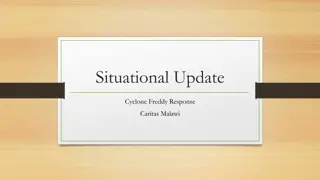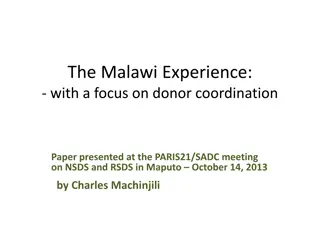Successful Scaling Up of CMAM Services in Malawi: A 7-Year Journey
With funding from the Malawi Ministry of Health, the CMAM Advisory Service in Malawi successfully scaled up CMAM services over seven years. They standardized service delivery, developed policies and guidelines, built capacity, established a monitoring system, and advocated for integration into the health system. Coverage of facilities reached 80%, with over 28,000 SAM children and 36,000 MAM children treated in 2012. The cure rates exceeded Sphere standards, showcasing the effectiveness of the program. The rapid scale-up was supported by focused guidelines, training packages, cadre of trainers, and coordination efforts, leading to successful outcomes.
Download Presentation

Please find below an Image/Link to download the presentation.
The content on the website is provided AS IS for your information and personal use only. It may not be sold, licensed, or shared on other websites without obtaining consent from the author.If you encounter any issues during the download, it is possible that the publisher has removed the file from their server.
You are allowed to download the files provided on this website for personal or commercial use, subject to the condition that they are used lawfully. All files are the property of their respective owners.
The content on the website is provided AS IS for your information and personal use only. It may not be sold, licensed, or shared on other websites without obtaining consent from the author.
E N D
Presentation Transcript
With funding from Malawi Ministry of Health CMAM Advisory Service in Malawi: seven years of scaling up Sylvester Kathumba, Nutritionist, Malawi Ministry of Health Kate Golden, Senior Nutrition Adviser, Concern, Dublin
Background: CAS timeline & objectives 2006: The government of Malawi expressed its intention to scale up CMAM for both SAM & lesser extent MAM 2006: CTC Advisory Services launched jointly by Concern & Malawi MoH; 5-year project (extended to 7) to: Standardize CMAM service delivery and tools Develop & roll out CMAM policy and guidelines Build capacity for CMAM service delivery at all levels Establish & manage a national CMAM reporting & monitoring system Advocate for strategic integration of CMAM into the health system 2013: Concern s formal support to CAS ended in March Final evaluation in July/August Malawi MoH now taking over CAS functions 2 of 9
Background: Malawi Malawi has: 5 zones 29 districts 618health centres Estimated SAM case load at any time: 39, 062 (under-five prevalence of 1.5%, DHS 2010) Estimated GAM case load at any time: 104, 167 (under-five prevalence of 4.0%, DHS 2010) 3 of 9
Findings: coverage of facilities = 80% 28,467 SAM children treated in 2012 and 36,122 MAM children 81% of health facilities in 24 of total 29 districts now provide CMAM services But, no national survey of beneficiary coverage conducted. 4 of 9
Findings: Cure rates above Sphere standards 5 of 9
Conclusions: what has worked Rapid scale up was facilitated by a fairly narrow CMAM focus CMAM guidelines finalised in 2007, recently reviewed CMAM included in Essential Health Package & national policies Standard CMAM training package developed for in-service & (some) pre-service training A cadre of CMAM trainers at national level (30) & district (290) responsible for ongoing training A costed CMAM Operational Plan helped coordinate actors 18 Learning Forums for real time exchanges & review of scale up Evolution of training curriculum to include practical aspects such as costing CMAM activities - most CMAM costs now included directly in District plans (minimal NGO funding direct to districts) 6 of 9
Conclusions: what could be improved CAS largely achieved objectives, but not enough focus on service quality Inclusion of CMAM training in pre-service curriculum depends on wider, sometimes complex curriculum development processes Support strategy focused too much at national level. District support was key, but not enough focus on zonal teams, who have become key players in the decentralisation process. Still need better monitoring of actual coverage of SAM cases (not just facilities) & strategies to identify & overcome access barriers as part of routine health service monitoring A costed CMAM operational plan proved useful, but only developed in year 2; commitments & progress not well monitored 7 of 9 Slow integration of CMAM database into HMIS complex process
Conclusions: future direction MoH will now take responsibility to: Regularly review the CMAM Operational Plan Decentralise monitoring to the Zone and district level Manage the CMAM database & integrate in HMIS Ensure all core CMAM activities are included in District Implementation Plans Many of the CAS platforms & mechanisms can now be utilised for scaling up broader nutrition interventions beyond CMAM 8 of 9
Zikomo! Thank you to all the partners in Malawi that have made the CMAM Advisory Services & the scale up of CMAM in Malawi a success This project was made possible by the generous support of the American people through the United States Agency for International Development (USAID) & Concern Worldwide. The contents are the responsibility of Concern Worldwide and do not necessarily reflect the views of USAID or the United States Government and/or implementing partners. 9 of 9























